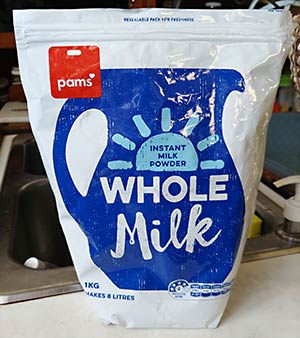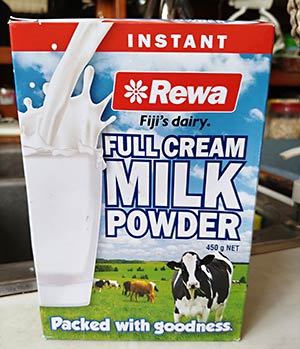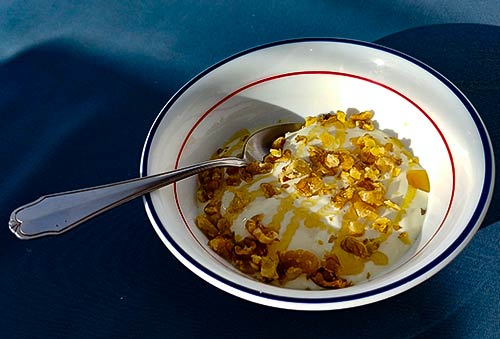August 31, 2018
While sitting out some higher winds here in Beqa, Fiji, we have a little time in our busy schedules (ha ha ha) to share a bit of information that was passed on to us by Sonya and Trevor on Lady Hawk in Tauranga, New Zealand. After all, for us, a big part of cruising is sharing.
They told us about making yogurt aboard. We’ve run in to a lot of cruisers that make yogurt, but somehow, Sonya made it more accessible. It’s now become an indispensable part of our cruising cuisine. Here’s how we make it.
We use an inexpensive yogurt maker, available in many grocery stores (even here in Fiji). We use this one from EasiYo.
Here’s the recipe that has evolved. (We’re really happy with the results.)
Step 1: Put two grotesquely heaping tablespoons of your previous batch of yogurt into the yogurt container as the “starter.” If we don’t have a previous batch, we make a batch from a pouch like this one.
Step 2: Add a little just slightly warm water, maybe an inch or so, and swirl it around to mix the yogurt and water together. (That’s 25 mm for you metric people, but you knew that, didn’t you?)
Step 3: Add 220 grams of powdered, full fat milk powder (update: now using 250 grams). We’re happy with the Pam’s brand we’ve been using but we’re running out so we tried another brand available here in Fiji and it’s just as good, if not a little better.
220 grams seems to be the magic number for us (update: now we’re using 250 grams). More powdered milk makes the yogurt thicker (like we like it), but too much makes it taste like powdered milk. We have an inexpensive digital scale we use to weigh out the powder. We zero it with the starter and water in the container.
Note: Maybe this should have been obvious to us, but it’s really hard to use this scale at sea! Before we leave on our next passage, we’ll weigh out zip-lock bags of powdered milk.
Step 4: Fill the yogurt container with warm water. Not hot. Just warm. Think really comfortable swimming pool temperature. Put the lid on and shake, shake, shake until all the milk powder is dissolved. Then top it up again with warm water and put the lid on (the water level goes down when the powdered milk mixes with water).
Update: Now we’re using cold water.
Step 5: Fill the EasiYo “thermos” with boiling water to the EasiYo suggested fill mark.
Step 6: Now the interesting part: We usually make our yogurt in the morning about 8 am. After making it, I set an alarm for 4 pm. At that point, I look at the yogurt. If it’s still a little runny, I leave it until we go to bed at about 8 pm (cruiser’s midnight!).
If it’s really runny, I dump out some water from the thermos and add boiling water to bring it back up to it’s recommended level and let it sit until bedtime.
I check it before we go to sleep. If it looks good when I tilt the container – if it looks thick enough, I put it in the refrigerator. If it’s still runny, I leave it overnight and put it in the refrigerator when I wake up.
With that procedure, I’m usually able to get nice, thick yogurt. Usually. Sometimes, it doesn’t thicken. If it’s really thin, like milk, I dump it and start again with a new package. I don’t know why the inconsistency. I don’t get too meticulous about the process. Maybe I should sterilize the container? Maybe boil the water I use to make the yogurt? But our results are good enough that it doesn’t seem worth the bother.
And when it’s right, which is most of the time, it’s amazing! It’s some of the best yogurt we’ve ever had! We add some walnut pieces and a drizzle of honey on top and it makes a great breakfast.
Update, April 30, 2020:
We’re now using 250 grams of powdered milk, mixing it with cold water (tap water).
We’ve found that if we shake the yogurt in the afternoon, before it gets thick, it will get really thick but slightly grainy, which is a good trade-off for us.
We’ll sometimes let the yogurt “cook” overnight to make it thicker. It’s a little more sour but a good sour taste, not too sour.
I’m no longer using the previous batch as a starter. I just buy yogurt starter at the health food store. It’s more consistent that way.
Occasionally, we’ll add a packet (50 grams) of dry coconut milk powder for really great coconut yogurt. That’s great with maple syrup and walnuts on it.
Headsets:
In the title I said “and Headsets.” Lady Hawk also recommend Sena “Marriage Saver” headsets. We bought a pair ($$$ expensive $$$) and wow, I can’t believe we’d lived without them! But that’s a subject for another blog post (coming soon). Hint: Sena may not be the best way to go.
Update, April 30, 2020:
Sena SUCKS! The quality is really poor and after a few months, one wouldn’t turn on at all. Before that, it would often quit after a few minutes of use and then not turn back on. There’s got to be a better product out there. I love the concept of the full-duplex headsets, and when they worked, there were great. They just didn’t work all that often.
Update:
We made our own headsets, mostly. Here’s more about it.
-Rich











